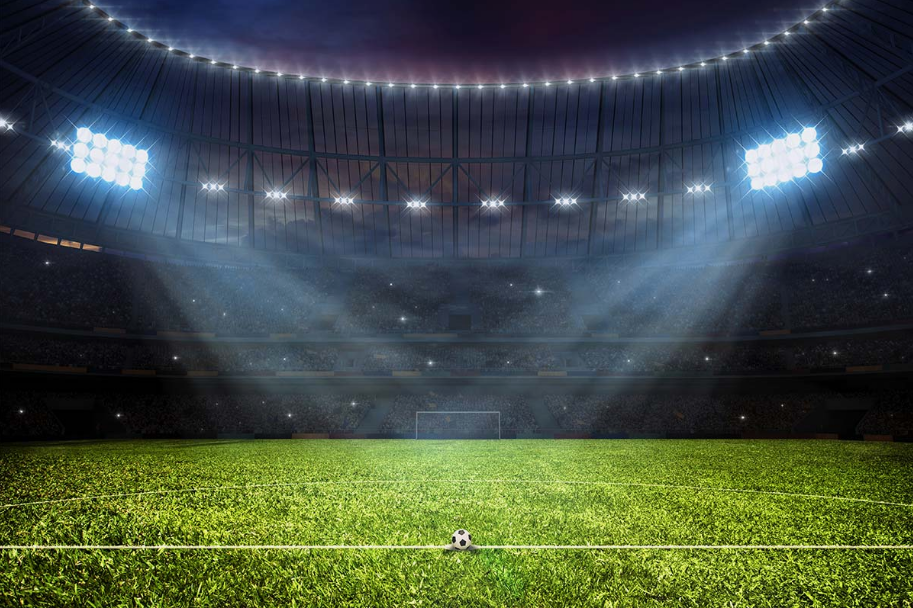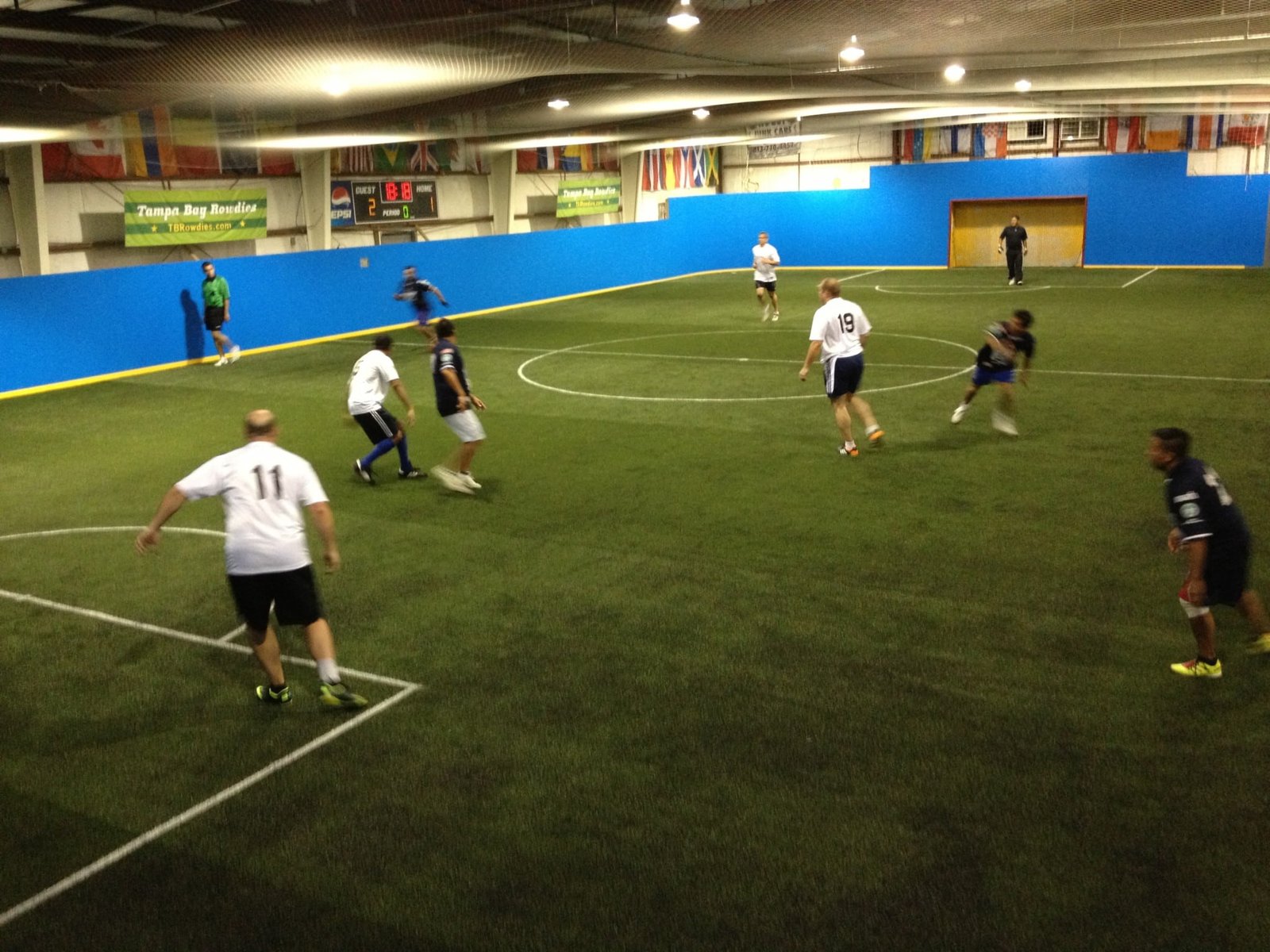An indoor soccer field is a facility designed for playing soccer in an enclosed environment. It typically features synthetic turf and size-adapted playing areas.
Indoor soccer, with its distinct pace and strategy, offers players the unique thrill of soccer year-round, regardless of the weather. These fields cater to sports enthusiasts who demand a consistent playing schedule, providing a venue for both casual play and organized competition.
The design usually incorporates walls or boards to keep the ball in play, enhancing the continuous action and requiring a different skill set compared to outdoor soccer. The synthetic turf emulates the feel of an outdoor pitch, complete with line markings and goal areas. These indoor complexes often host leagues, tournaments, and training sessions, making them a hub for community engagement and athletic development. From youth to adult leagues, indoor soccer fields play a key role in the growth of soccer at the grassroots level while offering an alternative to outdoor fields during inclement weather or winter seasons.

Benefits of Indoor Soccer Field
The benefits of having an indoor soccer field extend far beyond just avoiding rain. These facilities bring unique advantages that can transform the game of soccer. From year-round play to safety improvements, indoor fields are changing how players and fans experience the sport.
Year-round Availability
- No cancellations due to weather.
- Consistent playing schedules.
- Cool in summer, warm in winter.

Indoor soccer fields do not rely on the weather. Players can enjoy game day without worrying about rain or snow. Climate control means comfort in any season. This removes barriers to regular training and skill development.
Increased Safety
| Feature | Safety Benefit |
|---|---|
| Smoother playing surface | Reduces tripping hazards< |
| Indoor environment | Less exposure to sunburn or heatstroke |
Indoor soccer venues prioritize player safety. The flat, even playing surface decreases risks of trips and falls. A controlled environment protects against harsh sun and extreme temperatures. Athletes can focus on the game, without external risks.
Improved Performance
Fast-paced games on smaller fields build quick thinking and agility. Walls keep the ball in play, leading to more active game time and less downtime. This setting fosters skill enhancement and promotes a quicker reaction time.
Accessible To Everyone
No high barriers to entry. Indoor soccer fields are often located in urban areas, close to public transport. This makes them reachable to a wide array of players. Ambitious athletes of all ages find indoor fields inviting and accommodating.
Design And Layout
Kickstarting an indoor soccer arena takes thoughtful design and layout planning. Each element plays a pivotal role in ensuring the facility meets the standards for competitive play and casual fun. Discover the intricacies behind the size, surfaces, and markings that define an indoor soccer field.
Size And Dimensions
Indoor soccer pitches are typically smaller than their outdoor counterparts. The dimensions must cater to fast-paced, high-energy games while considering space constraints.
| Level | Length | Width |
|---|---|---|
| Professional | 100-130 feet | 50-100 feet |
| Amateur | 80-100 feet | 40-90 feet |
| Recreational | 25-50 feet (Mini) | 20-40 feet (Mini) |
Surface Material
The playing surface must ensure the ball rolls smoothly and players can move easily. Options include artificial turf, specially designed carpets, and various modular interlocking floor systems.
- Artificial Turf: Resembles grass texture minimizing injury risk.
- Sports Carpet: Provides cushion and traction.
- Modular Flooring: Delivers durability and ease of maintenance.
Field Markings
Distinct lines demarcate the playing area. They include boundaries, a halfway line, goal boxes, and penalty areas. Precision in these markings ensures fair play.
Color contrast is vital for clear visibility, often in white or yellow on green surfaces. Professional-grade fields use non-toxic paints or durable tapes for these markings.
Netting And Walls
Netting catches stray balls and protects spectators, while walls help keep the ball in play. They both serve to provide a seamless game flow and safety.
- Netting: Ranging in mesh sizes, positioned above the walls.
- Walls: Made of boards or plexiglass, stand about 4 to 8 feet tall.
Types of Indoor Soccer Fields
Welcome to the dynamic world of indoor soccer, where the game continues regardless of the weather outside. Indoor soccer fields provide the perfect arena to keep the game alive all year round. Different types of fields cater to varying styles of play and space constraints. Each offers a unique experience to the players. Let’s explore the options available.
Full-size Field
Full-size indoor soccer fields mirror the traditional outdoor soccer pitch. They often include sidelines, goals, and synthetic grass that mimics an outdoor field. Essential attributes:
- Length: around 100 yards
- Width: close to 60 yards
- Surface: Artificial turf similar to outdoor grass
Small-sided Field
Small-sided fields are a compact version ideal for 5-a-side matches or practice. They focus on skill development. Key features include:
- Smaller dimensions: Encourages quicker play
- Tightly packed action: Keeps players engaged
Bubble Fields
Bubble fields boast a unique, air-supported structure that encloses the playing area. Often referred to as “domes”, they offer protection from external elements. Highlights:
- Climate-controlled environment
- Year-round play: Unaffected by extreme weather
Two-field
The two-field configuration doubles the fun. It provides space for simultaneous games or larger tournaments. Typically, a divider separates the two fields. Notable aspects:
- Versatile space: Allows multiple games at once
- Adjustable layout: Can be used as one large field
Equipment For Indoor Soccer Field
Welcome to our deep dive into the equipment essentials for indoor soccer fields.
Each piece of gear plays a crucial role in gameplay. Let’s explore what you need to kit out your indoor soccer haven.

Soccer Balls
The heart of the game, soccer balls, must suit the indoor arena.
- Size 4 for younger players.
- Size 5 for adults and teens.
- Lower bounce for control on hard surfaces.
Goals And Nets
Goals are the centerpieces of the field.
- Sturdy frames to withstand impact.
- Dense nets to catch fast-moving balls.
- Portable or fixed options for versatility.
Field Markers
Bright, non-slip markers delineate boundaries.
- Durable and visible.
- Easy to set up and remove.
- Customizable for any field size.
Team Benches And Bleachers
Benches and bleachers provide comfort for teams and spectators.
| Item | Material | Features |
|---|---|---|
| Team Benches | Metal or Plastic | Portable, with or without backrests. |
| Bleachers | Aluminum or Steel | Weather-resistant, multiple tiers. |
Challenges To Indoor Soccer Field
Indoor soccer fields offer players the chance to enjoy soccer year-round. However, setting up an indoor soccer field comes with unique challenges. Let’s explore the key hurdles that facility operators face.
Ventilation And Temperature Control
Ensuring proper airflow and maintaining a comfortable temperature are vital for indoor sports facilities. Poor ventilation can lead to a buildup of stale air and odors, impacting player performance and comfort. Advanced HVAC systems are often required to keep air fresh and maintain consistent temperature levels, especially during intense matches.
Risk of Player Injuries
Indoor soccer fields typically have harder surfaces than outdoor grass fields. This increases the risk of player injuries. Field operators must choose the flooring that balances performance with safety and consider additional protective measures like padding around walls.
Maintenance And Repair
Maintaining an indoor soccer field is an ongoing responsibility. From repairing turf to fixing equipment, regular upkeep is needed to ensure a safe and appealing play area. Scheduling maintenance also means balancing field availability with necessary shutdowns for repairs.
High Initial Costs
Setting up an indoor soccer field requires a significant investment. Construction costs, high-grade turf, and sophisticated lighting all contribute to the budget. An operator must plan carefully to ensure the facility is financially viable from the start.
Indoor Soccer Field Tournaments
Indoor soccer field tournaments turn up the excitement level with fast-paced action. From kids having their first experience with team sports to seasoned athletes showcasing their skills, these tournaments have something for everyone. Fields become arenas of talent, teamwork, and triumph. Let’s take a closer look at the different levels of competition that grace these fields.
Youth Tournaments
Youth tournaments ignite the passion for soccer in young hearts and minds. They encourage teamwork, determination, and the joy of the game.
- Local clubs host seasonal leagues
- School teams compete in regional showcases
- All-star teams play in high-stakes championships
National Tournaments
National tournaments bring out the best from across the country. These events are prestigious, with scouts often in attendance.
- Teams qualify through rigorous competitions
- Winners earn national recognition and often scholarships
- It’s a chance to play against top-notch talent
International Tournaments
International tournaments welcome teams worldwide. These tournaments are about cultural exchange, skill, and global glory.
| Event | Countries Participating | Notable Rewards |
|---|---|---|
| Global Indoor Soccer Championship | Over 30 | International Cup |
| World Youth Indoor Soccer Expo | 20+ | Talent Recognition |
Indoor Soccer Field Leagues
An indoor soccer field hosts fast-paced games, safe from weather’s whims. It’s perfect for players eager to sharpen skills, enjoy the sport, and compete year-round. Both young athletes and seasoned professionals find a home here, in leagues structured for their skill levels and aspirations.
Youth Leagues
Starting young in soccer has numerous benefits. Hand-eye coordination, teamwork, and sportsmanship are among them. Youth leagues provide this foundation in a fun, energetic environment.
- Age-appropriate competition: Teams are grouped by age to ensure fair play.
- Skill development: Techniques and strategies are tailored to young players.
- Seasonal sessions: Many leagues offer fall, winter, and spring options.
Professional Leagues
Professional indoor soccer leagues showcase top-tier talent. Here, the stakes are higher and the plays are quicker. Passionate fans can witness soccer at its most thrilling level.
| League Features | Benefits |
|---|---|
| Experienced Players | Watch and learn from the best. |
| Advanced Coaching | Elevate your game with pro insights. |
| Year-Round Play | Enjoy soccer any time, regardless of the weather. |
Future of Indoor Soccer Field
The future of indoor soccer fields is bright and dynamic. Innovative designs and technologies are shaping the way players engage with the sport. Fields are becoming more sustainable and environmentally friendly. The worldwide growth of indoor soccer spells out a new era. Especially in the United States, the sport’s popularity is surging. Let’s explore what’s unfolding in indoor soccer’s exciting future.
Innovative Technologies
Indoor soccer fields are embracing cutting-edge technologies. Smart floors can track player movements. Walls equipped with interactive displays bring new training methods. New software helps with tactics and game analysis. These developments make the game more engaging and advanced.
Sustainable And Environmentally-friendly Options
- LED lighting reduces energy consumption.
- Recycled materials are used for turf and seating.
- Green buildings house soccer fields, lowering carbon footprints.
- Water-saving fixtures contribute to resource conservation.
Growth of Indoor Soccer Around The World
More countries are building indoor soccer fields. These places provide year-round access to soccer. Both adults and kids enjoy playing indoors, away from bad weather. Leagues and tournaments are expanding worldwide. This is creating a global indoor soccer community.
Increased Popularity In The United States
| Year | New Indoor Soccer Facilities |
|---|---|
| 2020 | 50+ |
| 2021 | 75+ |
| 2022 | 100+ |
Americans are turning to soccer for fitness and fun. New facilities are popping up nationwide. They offer leagues for all ages and skill levels. Soccer as a sport is gaining traction in the US. Hence, indoor fields are now more popular than ever.
Frequently Asked Questions on Indoor Soccer Field
How many feet is an indoor soccer field?
An indoor soccer field typically measures between 180 to 220 feet in length.
How much space do you need for indoor soccer?
An indoor soccer field typically requires at least 25 yards in length and 15 yards in width. Standard sizes may reach 200 feet by 85 feet for professional-level play.
What is an indoor soccer field size?
An indoor soccer field typically measures around 200 feet in length and 85 feet in width, but sizes can vary based on facility specifications.
Conclusion
Wrapping up, and embracing indoor soccer can significantly enhance your game, whatever the weather outside. It’s a high-energy, intensive way to keep fit, refine skills, and enjoy the beautiful game year-round. Don’t let the seasons dictate your play—find a local indoor field and keep the ball rolling anytime.
